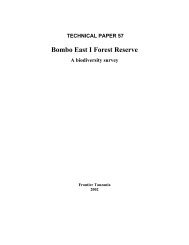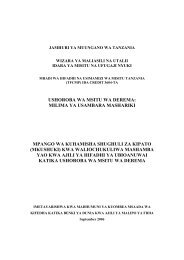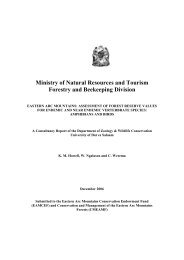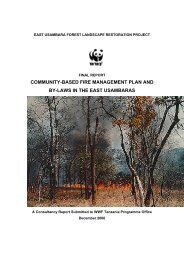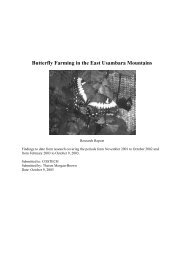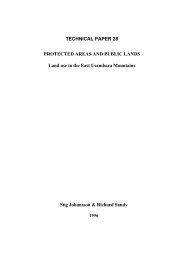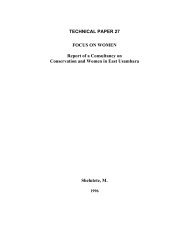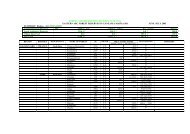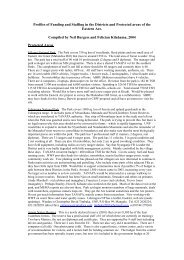Mgambo Forest Reserve: A biodiversity survey. - Eastern Arc ...
Mgambo Forest Reserve: A biodiversity survey. - Eastern Arc ...
Mgambo Forest Reserve: A biodiversity survey. - Eastern Arc ...
You also want an ePaper? Increase the reach of your titles
YUMPU automatically turns print PDFs into web optimized ePapers that Google loves.
<strong>Mgambo</strong> <strong>Forest</strong> <strong>Reserve</strong><br />
Table 22 Summary of dung <strong>survey</strong> in <strong>Mgambo</strong> FR.<br />
Species Ecol.<br />
type<br />
CERCOPITHECIDAE<br />
Papio cynocephalus<br />
Yellow Baboon<br />
HERPESTIDAE<br />
Unknown sp.<br />
Mongoose<br />
THRYONOMYIDAE<br />
Thryonomys sp.<br />
Cane-Rat<br />
VIVERRIDAE<br />
Civettictis civetta<br />
African Civet<br />
Genetta genetta.<br />
Common Genet<br />
ANTILOPINAE<br />
Cephalophus sp.<br />
Duiker sp.<br />
Madoqua sp.<br />
Dik Dik<br />
Capra hircus<br />
Domestic Goat sp.<br />
RHYNCHOCYONINAE<br />
Rhynchocyon sp.<br />
Giant Elephant Shrew<br />
sp.<br />
BOVIDAE<br />
Domestic cow sp.<br />
f<br />
?<br />
?<br />
O<br />
O<br />
f<br />
End.<br />
status<br />
W<br />
?<br />
?<br />
W<br />
W<br />
W<br />
IUCN<br />
2000<br />
Threat Status<br />
UDSM<br />
1997<br />
CITES<br />
2001<br />
East Usambara Conservation Area Management Programme Technical Paper 59<br />
No. of<br />
occurrences<br />
49<br />
Altitude<br />
of dung<br />
findings<br />
II 11 420-670<br />
1 550<br />
10 350-685<br />
1 360<br />
3 410-520<br />
1 680<br />
? ? 3 450-500<br />
O W 3 450-620<br />
?<br />
O<br />
?<br />
W<br />
1 620<br />
9 370-720<br />
For key to abbreviations, see Table 21.<br />
5.4.1.3 Mammal observations<br />
A total of 22 species from 14 families were observed directly and indirectly but not retained for<br />
taxonomic purposes. This included species detected from the presence of tracks, paths, diggings<br />
and feeding sites, but not those detected through the dung <strong>survey</strong>. All mammal observations are<br />
summarised in Table 23. As many observations were made by indirect means, positive<br />
identification was not always possible to a species level. An ‘identification confidence’ column<br />
clarifies the reliability of each sighting. Identification is ranked as follows: Certain, Near Certain,<br />
Probable, Possible.<br />
Of particular interest was the sighting of the Rhynchocyon petersi (Zanj elephant shrew) which is<br />
forest-dependent, near endemic and endangered (IUCN 2000). (Table 23). Observations were<br />
made of up to six different groups of forest dependent Colobus angolensis palliatus (Black and<br />
white colobus monkey) in patches of lowland and riverine forest throughout the reserve. These<br />
primates, although considered widespread, seem to be limited to rapidly decreasing areas of<br />
lowland forest and must be at risk from local extinction due to limitations to disperse and<br />
interbreed. Also of interest was the sighting of the vulnerable (IUCN 2000) Paraxerus palliatus<br />
(Red bellied coastal squirrel).<br />
Five nocturnal species were seen and/or heard at trapsite 3, an area of good lowland and riverine<br />
forest. These were the Dendrohyrax validus (<strong>Eastern</strong> tree hyrax), which is near endemic and<br />
vulnerable (IUCN 2000); Galagoides zanzibaricus (Zanzibar galago), a forest-dependent species;



